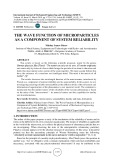
http://www.iaeme.com/IJMET/index.asp 1725 editor@iaeme.com
International Journal of Mechanical Engineering and Technology (IJMET)
Volume 10, Issue 03, March 2019, pp. 1725–1734, Article ID: IJMET_10_03_174
Available online at http://www.iaeme.com/ijmet/issues.asp?JType=IJMET&VType=10&IType=3
ISSN Print: 0976-6340 and ISSN Online: 0976-6359
© IAEME Publication Scopus Indexed
THE WAVE FUNCTION OF MICROPARTICLES
AS A COMPONENT OF SYSTEM RELIABILITY
Nikolay Ivanov Petrov
Institute of Metal Science, Equipment and Technologies with Hydro- and Aerodynamics
Centre ,,Acad. A. Balevski” – Bulgarian Academy of Sciences,
67, Shipchenski prohod St. 1574 Sofia, Bulgaria
ABSTRACT
This article is based on the following scientific proposal, stated by the genius
German physicist Max Planck: “No matter can exist on its own. All matter originates
and exists only by virtue of a force which brings the particle of an atom to vibration and
holds this most minute solar system of the atom together. We must assume behind this
force the existence of a conscious and intelligent mind. This mind is the matrix of all
matter“ [1].
The article discusses the wavelength function of the microcosmos, introduced by
Planck as a component of system reliability and its sustainability. In this aspect, we are
investigating ensuring reliable sustainability at the different levels of the structural and
informational organization of the phenomena in our material world. The statement is
maintained that the unified nature of the reliability of the various phenomena is based
on the unity of the "microcosmos" - its material nature and the capability for duality
and transformations.
Key words: Reliability, microcosmos, sustainability, duality and trans-formations
Cite this Article: Nikolay Ivanov Petrov, The Wave Function of Microparticles as a
Component of System Reliability, International Journal of Mechanical Engineering
and Technology 10(3), 2019, pp. 1725–1734.
http://www.iaeme.com/IJMET/issues.asp?JType=IJMET&VType=10&IType=3
1. INTRODUCTION
The author of this paper proposes a study of the mechanism of the reliability of matter and its
forms at the different levels of its structural organization. The notion of reliability is applicable
in the world of the microcosm, as it reflects the physical nature of elementary particles that we
are investigating. When observing the state of the microparticles (elementary particles),
Planck's constant appears to be the absolute measure of uncertainty. In this sense, it should be
pointed out that the uncertainty principle of Werner Heisenberg states the following:
“Absolutely accurate measurement in the micro and macro world is impossible ! “[2, 3, 4].
Based on the principle of causality in physicochemistry, Max Planck poses the question in
another way: "Are we obliged to seek a constant explanation of the universal unreliability and
inaccuracy, associated with any physicochemical observation? It may be attributed to the





















